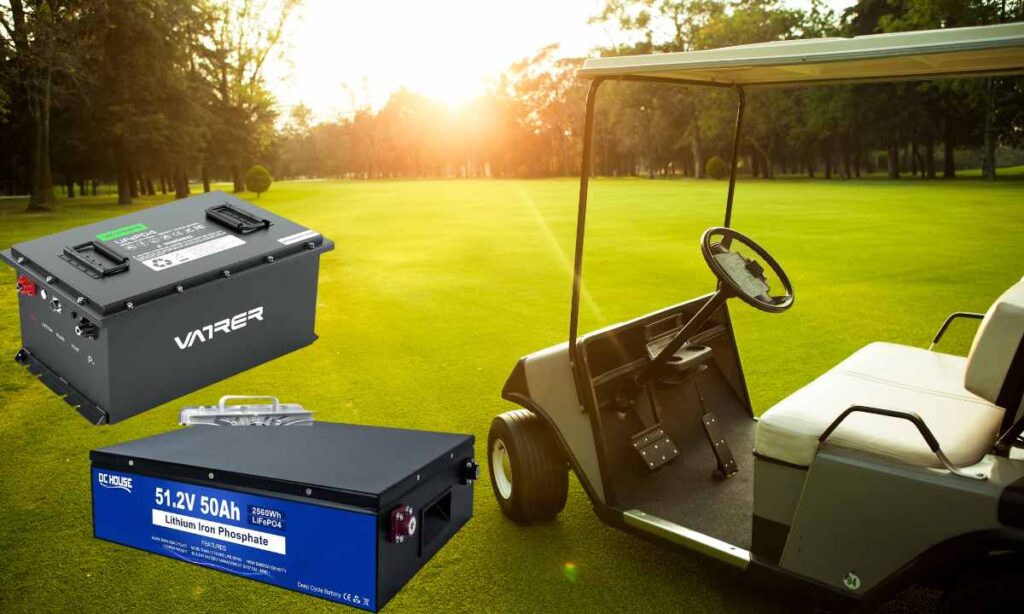Golf carts are essential for golf. They make it easy to traverse the large greens of courses. Golf cart batteries are crucial to these carts. They provide the power to move a cart through 18 holes and more. The quality of performance, longevity, and cost of golf cart batteries determine how well you will enjoy your success on the golf course. The market is rejuvenated and offers many battery options. Appreciating the distinction among golf cart battery types for an informed purchase is critical. How much are golf cart batteries are actually ?
Three varieties of batteries are generally used in golf carts: lead-acid, AGM, and lithium-ion batteries. Each has its benefits, limitations, and costs. The cheapest to buy are lead-acid ones. But, due to their shorter lifespan and regular maintenance, this option is the most expensive long-term. It also has a fourth option, an AGM battery, a type of lead-acid choice. The cost is moderate, but durability is increased, so it remains a golden mean. Lithium-ion batteries are the costliest type. But, their high price is offset by their long life, quick charging, and lightweight.
In conclusion, golf cart batteries are becoming a critical choice for the golfing community looking to become more efficient and sustainable. This paper covered many aspects of golf cart batteries. It looked at their costs and maintenance compared to other batteries and covered future trends. These should give golfers and course owners the information they need to make a good choice.
Understanding Golf Cart Batteries
Golf cart batteries are more than just a power source; they are the heart of the golf cart’s operational capabilities. You must understand the available types to choose the correct battery for a golf cart. Each type has its advantages and disadvantages. It would help if you also considered lifespan and durability.
Types of Golf Cart Batteries
- Lead-Acid Batteries
- Pros:
- Price: Lead-acid batteries are the cheapest option. They are popular with budget-conscious buyers.
- Availability: These widely available batteries come in various sizes and capacities.
- Cons:
- Maintenance Requirements: They require regular maintenance, including water level checks and terminal cleaning.
- Weight: Heavy lead-acid batteries impact the cart’s efficiency and handling.
- Environmental Impact: They use a lot of lead and sulfuric acid. These can be harmful if not disposed of properly.
- Pros:
- AGM Batteries
- Pros:
- Reduced Maintenance: AGM batteries are sealed and do not require water to be added, reducing upkeep efforts.
- Durability: They are more vibration-resistant and can withstand rougher handling without suffering damage.
- Performance: Offers better performance in colder climates compared to standard lead-acid batteries.
- Cons:
- Cost: AGM batteries are more expensive than traditional lead-acid batteries.
- They are sensitive to overcharging. It can damage them, so you must manage charging carefully.
- Pros:
- Lithium-Ion Batteries
- Pros:
- Longevity: Lithium-ion batteries can last up to 2-3 times longer than lead-acid batteries.
- Price: They charge faster. They keep a steady voltage throughout use, which provides more reliable power.
- Lightweight: These batteries are significantly lighter, which can improve the performance and portability of golf carts.
- Cons:
- Initial Cost: The upfront cost is higher, although the longer lifespan and lower maintenance costs can offset this.
- Specialized Chargers: Lithium-ion batteries require specific chargers and management systems, which can add to the initial investment.
- Pros:
Lifespan and Durability
The lifespan of golf cart batteries can vary significantly based on the type, usage, and maintenance practices.
- Lead-acid batteries typically last 3 to 5 years if properly maintained. However, deep discharging and poor maintenance can shorten their lifespan.
- AGM batteries offer a similar lifespan. But they are less prone to damage from deep discharges. They can handle more charge cycles than traditional lead-acid batteries.
- Lithium-ion batteries stand out in this group. They can last up to 10 years and handle many more charge and discharge cycles without much damage.
A battery’s durability is not only a matter of lifespan but also how well it can maintain its capacity and performance over time. Regular maintenance and proper charging are crucial. They make golf cart batteries last as long as possible, no matter their type. Lithium-ion batteries need little maintenance. However, you must handle and charge them correctly to prevent issues like overheating.
In conclusion, knowing the types of golf cart batteries is vital. You must understand their benefits, downsides, lifespan, and durability. This knowledge is critical for those choosing and maintaining golf carts. The right choice depends on budget, usage patterns, and maintenance. You must consider them to ensure the best performance and cost-efficiency.
This completes our detailed examination of the different types of golf cart batteries. Next, we will explore the factors influencing the cost of these batteries to help you make an informed financial decision.
Factors Influencing the Cost of Golf Cart Batteries
The cost of golf cart batteries can vary significantly based on several key factors. Understanding these parts can help buyers choose a battery. It ensures they balance cost with performance and longevity.
Battery Capacity and Voltage
Capacity
- The capacity of a battery, measured in ampere-hours (Ah), directly influences its price. Bigger batteries have more power and range. These are vital for carts used on extensive courses or for long periods. Therefore, they command a higher price due to the increased materials and technology required to produce them.
Voltage
- The voltage of a battery determines the power output and efficiency of the golf cart. Standard voltages for golf cart batteries include 6V, 8V, and 12V. Higher-voltage systems often need fewer batteries to reach the same power as lower-voltage setups. This difference can affect the total cost. For example, a 48V system might use four 12V batteries or six 8V batteries; the choice impacts both the initial and maintenance costs.
Brand and Manufacturer Reputation
Brand Recognition
- Famous brands often charge more for their batteries. They do this because they have a reputation for quality and reliability, and they can command a high price. This price reflects their past performance, service, and consumer trust.
Quality and Manufacturing Standards
- Premium manufacturers invest significantly in research and development, adhering to higher manufacturing standards. This investment enhances the battery’s reliability and life expectancy and increases the cost.
Warranty and Support
Warranty Length
- Longer warranties show a manufacturer’s confidence in their product and can justify a higher price. Warranties cover anything from a few months to several years and can significantly influence the total cost of ownership by mitigating replacement costs.
Support Services
Some manufacturers offer extensive customer support services. They include help with installation and advice on recycling and maintenance. These services add value to the purchase but also impact the price of the batteries.
Technological Advancements
Innovative Features
- Better batteries can drive up costs. They have new systems that boost charge cycles and efficiency. These features improve the battery’s performance and lifespan. They appeal to users who prioritize long-term savings over upfront costs.
Material Costs
- Advanced materials, such as lithium-ion over lead acid, generally involve higher costs. However, they can be more efficient and green, which may justify their higher cost.
Eco-Friendliness
- These batteries are marketed as eco-friendly. They have lower lead or advanced recycling. They can also command a higher price. Consumers are more willing to pay extra for products that reduce environmental harm.
Understanding these factors helps buyers weigh the upfront costs against the potential long-term benefits, which include lower maintenance, longer life, and better performance. This understanding is crucial. It helps in making a cost-effective decision when buying golf cart batteries.
How much are golf cart batteries ?
When buying golf cart batteries, know the price range. Understand the factors that affect cost. This is crucial for budgeting and investing. Here, we discuss the usual costs of different golf cart batteries. We provide case studies and examples to show accurate prices.
Price Range for Different Types of Batteries
Lead-Acid Batteries
- Typical Costs: The most economical option is lead-acid batteries for golf carts, ranging from $100 to $200 per battery. A complete set to power a standard 36V or 48V golf cart might cost between $600 and $1200, depending on the brand and specific requirements of the cart.
- Case Study: For example, a popular model of 6V lead-acid batteries used in many 36V golf carts is often found priced at around $120 per unit. A complete set of six would cost approximately $720.
AGM Batteries
- Typical Costs: AGM batteries, which offer better performance with less maintenance, can cost between $200 and $300 per battery. For a typical 48V golf cart, the total cost for AGM batteries would be between $800 and $1200.
- Case Study: A golf course manager opted for AGM batteries at $250 each for a fleet of carts. The initial cost is higher. But, the lower maintenance costs and longer life save more over time.
Lithium-Ion Batteries
- Typical Costs: Lithium-ion batteries represent the high end of the market, with prices ranging from $500 to over $1,000 per battery. A set for a 48V golf cart can cost anywhere from $2,000 to $4,000.
- Case Study: A luxury golf resort recently upgraded its carts to lithium-ion batteries for $3,500 per cart. The investment was justified. The batteries had a vastly better lifespan, nearly zero upkeep, and better performance, including faster charging and lighter carts.
Factors Contributing to Higher or Lower Prices
Capacity and Power
- Batteries with more power and capacity cost more. This is because they need more materials and technology. For example, a 150 Ah lithium-ion battery will be significantly more expensive than a 100 Ah model due to its extended range and longevity.
Technological Innovations
- Batteries have advanced technology. Some have built-in Bluetooth for monitoring, and others have chemicals for faster charging and longer life. These features often make them cost more.
Brand and Warranty
- Premium brands that offer extensive warranties and customer support might price their batteries higher, reflecting the added value of reliability and service. Lesser-known brands provide reasonable prices. But they need shorter warranties and more support.
Market Demand and Availability
- Seasonal demand and supply chain issues can affect prices. For instance, during times of high demand, prices may increase due to limited availability. Similarly, prices might drop during off-peak seasons or when new models are about to be released.
Understanding these price ranges and factors can help golf cart owners and fleet managers make better choices that fit their needs and budgets. Initial costs matter. However, it would help if you also considered the total cost of ownership, which includes maintenance and expected lifespan.
Maintenance and Care for Golf Cart Batteries
Proper maintenance and care are critical. They extend the lifespan and ensure good performance of golf cart batteries. This section provides tips and common practices for maintaining golf cart batteries and explains how these efforts can cut costs.
Tips on Extending Battery Life
Regular Charging
- Consistent and correct charging is pivotal. Batteries should be charged after each use, regardless of the duration of use. Avoiding deep discharges (letting the battery drain completely) extends the battery’s life.
Temperature Considerations
- Store and charge batteries in a temperature-controlled place. Extreme heat and cold can harm battery performance and lifespan. Keeping batteries at moderate temperatures helps maintain their efficacy and longevity.
Balanced Charging
- Use a quality charger that correctly balances the charge among all batteries in a series. This ensures each battery keeps the best charge levels. It prevents overcharging or undercharging, which can harm batteries.
Water Levels in Lead-Acid Batteries
- Check and maintain water levels in lead-acid batteries often. Make sure the water covers the plates well. Use only distilled water to avoid introducing impurities that can corrode the battery.
Common Maintenance Practices
Regular Inspections
- Inspect batteries routinely for signs of wear or damage, such as cracks, leaks, or bulging. These inspections can prevent minor issues from becoming major problems.
Cleaning Terminals
- Use a mixture of baking soda and water to keep battery terminals clean and free from corrosion. This not only ensures good connectivity but also prevents power losses and potential short circuits.
Tightening Connections
- Ensure that all battery connections are secure and tight. Loose connections can lead to reduced performance and increased wear on the battery.
Equalization Charge
- For lead-acid batteries, perform an equalization charge periodically. This process helps to balance the battery cells and correct the specific gravity in each cell, which can drift apart over cycles.
The Impact of Maintenance on Overall Cost Effectiveness
Maintaining golf cart batteries properly has a direct correlation to their total cost of ownership:
- Extended Battery Life
- Proper maintenance can significantly extend a battery’s lifespan. For example, a well-kept lead-acid battery could last up to two years longer than a neglected one, reducing the need for costly replacements.
- Improved Performance
- Regularly maintained batteries deliver consistent performance. This reliability ensures the golf cart is always ready for use, making customers happier and reducing downtime.
- Reduced Long-Term Costs
- Maintaining batteries requires a small upfront investment in time and resources. This includes buying distilled water and cleaning tools. However, the cost is minimal compared to prematurely replacing a battery due to neglect.
- Avoidance of Major Repairs
- By catching issues early through routine inspections and care, you can avoid the higher costs of major battery failures or damage. Such damage might also impact other parts of the golf cart.
In conclusion, battery maintenance might seem like an extra task. But its impact on the lifespan, performance, and cost of golf cart batteries is huge. Following these tips saves money and keeps the golf carts in peak condition, ready to deliver a seamless golfing experience.
Replacement and Disposal of Golf Cart Batteries
Proper battery management continues after daily maintenance. It also includes timely replacement and responsible disposal. This straightforward guide for golf cart owners will discuss when to replace your batteries, how to dispose of them safely, and the costs involved.
When and How to Replace Your Golf Cart Batteries
- Recognizing Replacement Signs
- Performance Decline: If your golf cart shows reduced range or slower speeds, it might be time to check your batteries.
- Physical Damage: Look for visible signs such as swelling, leakage, or cracked cases.
- Age: Typically, lead-acid batteries last about 3-5 years, AGM batteries around 4-6 years, and lithium-ion can last up to 10 years. Consider a replacement if your batteries are nearing the end of these ranges and showing performance issues.
- Steps for Replacement
- Check Specifications: Ensure you purchase the correct type and size of battery for your golf cart.
- Safety First: Wear protective gear, disconnect the power, and carefully remove old batteries to avoid spills or shorts.
- Proper Installation: Install the new batteries, ensuring all connections are secure and correctly aligned, then charge the new batteries full charge before use.
Environmentally Safe Disposal Practices
- Recycling Centers
- Take your old golf cart batteries to a certified recycling center. These facilities handle the toxic parts well. They often recover materials for new batteries.
- Manufacturer Take-Back Programs
- Some battery manufacturers offer take-back programs where they collect used batteries for recycling. This not only ensures safe disposal but also promotes sustainability within the industry.
- Avoiding Landfills
- Never dispose of batteries in landfills. The chemicals in batteries can leach into the ground, causing environmental damage and posing health risks.
The Cost of Replacement and Disposal
- Replacement Costs
- The cost depends on the battery type. Lead-acid batteries are usually the cheapest, costing a complete set $600 to $1200. In contrast, lithium-ion batteries can cost $2000 to $4000 for a set.
- Consider the long-term savings from pricier batteries. They cost more upfront but last longer and need less maintenance.
- Disposal Costs
- Many recycling centers will take old batteries at no cost, as the materials can be reclaimed for profit. However, some places charge a small fee for handling or processing.
You must replace and dispose of golf cart batteries properly. This will keep your golf carts working well and help the environment. Upfront costs are balanced by long-term savings and responsible practices that protect our planet.
Future Trends in Battery Technology
Battery technology is always changing. Innovations drive the changes, promising to revolutionize not only golf carts but all-electric mobility. We look to the future. Several new technologies and trends will reshape golf cart batteries, changing their efficiency, cost, and sustainability. Knowing these trends can help golf fans and course operators make better choices, ensuring that they invest in high-performing and valuable tech in the long run.
Innovations on the Horizon
- Solid-State Batteries: One of the most anticipated advancements in battery technology is the development of solid-state batteries. These batteries replace the liquid or gel electrolytes in traditional lithium-ion batteries with a solid, conductive material. Solid-state batteries have many benefits. They are more stable and have higher energy density. They are also potentially safer and less likely to catch fire. This could mean lighter batteries, faster charging, and more power for golf carts. This would extend the range and reduce the need for charges.
- Advanced Lithium-Ion Technologies: Lithium-ion batteries are better than lead-acid ones. However, researchers keep improving their composition and design. Researchers are developing innovations, such as silicon anodes and sulfur cathodes. These innovations aim to increase battery capacity and reduce degradation. These changes could lower the cost per kilowatt-hour. They could also extend the battery’s life. This would make them more cost-effective in the long run.
- Recycling: Battery recycling and second-life uses are growing. The demand for batteries is growing, so we need sustainable and affordable recycling. Future trends include not only better recycling but also finding uses for batteries that have declined. For example, used golf cart batteries can be repurposed for stationary storage. They can power lights and facilities at golf courses, reducing waste and supporting the environment.
- Wireless Charging Systems: Imagine driving your golf cart onto a charging mat and having it charge without the need to plug it in. Inductive charging is wireless. It is developing fast and could soon offer this convenience. This would make charging golf carts easier. It could be integrated into parking spots. This would reduce the work of maintaining traditional charging stations.
- Future batteries are likely to be more innovative. They will have IoT tech that allows real-time monitoring of battery health and performance. Intelligent battery management systems could optimize charging rates. They would do this based on usage patterns and environmental conditions. This would significantly improve battery efficiency and lifespan. For golf courses, this means better fleet management and reduced downtimes due to battery maintenance.
Impact on Costs and Efficiency
These tech advances will greatly affect the cost and efficiency of golf cart batteries. At first, solid-state batteries may be more expensive to make. But, like with most tech, costs will likely fall as the tech matures and scales. Efficiency and longer lifespans will offset higher upfront costs, and they will provide more value for money over time.
Also, better recycling tech and second-life uses will make batteries more sustainable. They could cut the environmental cost of disposal and save valuable materials that would otherwise go to waste.
Last VERDICT
Choosing the correct battery for your golf cart is more than a routine purchase. It’s an investment in the quality and joy of your golfing. The battery you choose affects everything. It impacts the cart’s performance and range. It also affects the cart’s operating costs and maintenance needs. We’ve explored this throughout. The choice is between lead-acid and lithium-ion batteries. Or, one might opt for new tech in the future. The key is to balance upfront costs, lifespan, efficiency, and advancing tech.
To invest wisely in good batteries, prioritize ones that meet your needs now. They must also be reliable and efficient in the long run. Battery technology is evolving. Staying informed about the latest advancements can help you make choices. The choices should align with the environment and be efficient. Golf course operators need this knowledge. It is crucial for managing fleets of carts. They must be cheap to maintain and fun for golfers to use.
We encourage all golf enthusiasts and course operators to consider two things. They should consider the upfront costs of their golf cart batteries and the broader impacts of their choices. Technology is advancing rapidly. The batteries you choose today will significantly impact your golfing experience tomorrow. Investing in the right technology means you’re not just buying a battery. You’re making the game better for everyone who steps onto your course.
In conclusion, whether you’re a casual golfer or a golf course manager, taking the time to understand and invest in good golf cart batteries pays off. It improves play, cuts maintenance downtime, and helps golf’s future. Choose wisely and see how the correct battery can transform every drive on the green.
mustakimsajib007

7 Essential Tips Every Beginner Golfer Should Know
Though it’s not always simple to get started, golf is drawing more new players than ever before. It is normal to feel uncertain about everything

Cut Grey Golf Balls Review 2025: Affordable Performance with Exceptional Value
Golf is one of the most expensive sports, and one of the biggest costs can come from purchasing quality golf balls. With many premium golf

How to Maintain Golf Cart Batteries: Essential Tips for Longevity
Batteries play a crucial role in the performance of a golf cart. Without a healthy battery, you will not get the expected performance from your

Discover the Perfect Balance of Performance and Value: My Experience with WILSON Staff Zip Golf Balls
Selecting the right ball while playing golf is very crucial. It can make a huge difference in your game. As an intermediate golfer, I try

Bozily Golf Rangefinder Review: A Reliable Rangefinder That Surpasses Expectations
Golfers of all levels understand the value of accurate distance measurements. To ensure it, some turn to premium brands like Bushnell or Leupold, and others

Best Rangefinders for Golf Under $100: Affordable Precision for Every Golfer
Finding a reliable and accurate golf rangefinder that meets all your needs for just under $100 can be challenging. Many golfers assume they have to spend hundreds







Pingback: How Much Are Golf Carts? | Discover Golf Cart Prices & Costs